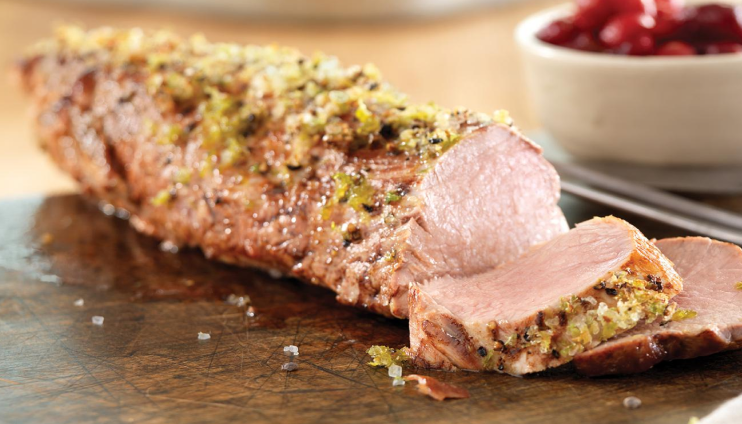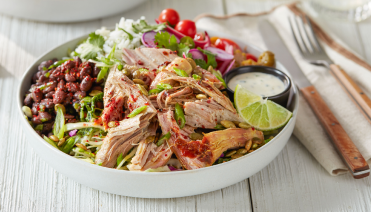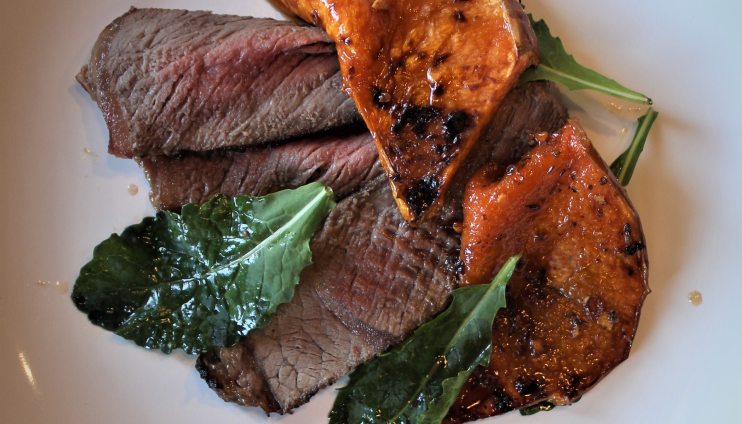TYSON FOODS, INC. TRADEMARKS AND REGISTERED TRADEMARKS ARE OWNED BY TYSON FOODS, INC. OR ITS SUBSIDIARIES.
Beef Ribs vs. Pork Ribs: Everything You Need to Know
Published: June 4, 2024
For a menu differentiator that’s cost-efficient, versatile and crowd-pleasing, stick with ribs. The majority (96.8%) of barbecue restaurants menu ribs.1 And whether you’re considering adding beef or pork ribs to your menu, you’ll want to choose cuts that help you stand out from competitors. Here’s why.
According to the latest research:
- 23.5% of all operators have ribs on their menu2
- 32.5% of BBQ restaurants menu pork ribs, with a +4.1% 12-month menu penetration growth1
- 17.8% of BBQ restaurants menu beef ribs, with a +3.7% 12-month menu penetration growth1
- Barbecued is the most preferred preparation style for pork, according to 39% of consumers ages 35+ and 32% of consumers ages 18-343
Take a second look at those statistics. Even among operators that serve pork, more than half don’t serve rib cuts. That leaves plenty of room for innovation, creativity and experimentation to create fall-off-the-bone ribs your patrons will crave.
If that piques your interest, here’s what you need to know to select the best rib cuts for your menu.
Beef Ribs vs. Pork Ribs
It goes without saying that pork ribs and beef ribs have very different flavors, mouthfeels and meatiness. Here’s a high-level overview of the attributes offered by each.
BEEF RIBS
- Meaty and well-marbled, beef ribs are best cooked low and slow
- Only require simple seasoning because of their strong flavor
- Some cuts are more appropriate for fine dining when braised and featured center-of-plate in French, Asian and fusion dishes
PORK RIBS
- A large variety of cuts
- Better meat-to-fat ratio than beef ribs
- Less connective tissue than beef ribs, making pork ribs easier and
faster to cook - Usually more cost efficient than beef ribs
- Mild flavor makes it easy to incorporate a variety of sauces and rubs
Chef’s Tip: Beef ribs benefit from marinating and smoking and require less intense spices to acquire flavor. Pork ribs offer a better profit margin because of their lower initial cost and are easier and faster to cook, requiring less labor as well.
- Chef Christophe Setin
Beef Ribs Cuts
There are two categories of beef ribs: back ribs and short ribs. Of the two, back ribs are used most often in barbecue. What’s more, nearly half (49%) of consumers see beef dishes as comfort foods.3
Beef Back Ribs vs. Short Ribs
The distinction between these ribs really matters. Back ribs come from the rib primal, while short ribs are a category of different cuts from different primals. Different primals mean different weights, meatiness and optimal cooking methods.
So what do back ribs and short ribs have in common? Great beefy flavor that requires only simple seasoning.
Chef’s Tip: Because of their strong beef flavor, beef back ribs do not require heavy seasoning, but can be complemented with a thin layer of mustard and your favorite meat rub. They can be cooked, cooled and reheated very easily, making them a low-labor item with good profit margin.
- Chef Christophe Setin
A Trio of Short Ribs
Popular beef short ribs for foodservice include rib short, chuck short and dino short. Any of these rib cuts can be cooked bone-in or boneless and tend to have more meat than back ribs.
Rib Short Ribs
Cut from the rib primal, rib short ribs respond best to grilling, braising or slow roasting. They can be served bone-in or boneless, and typically have more meat than back ribs. Their bones are shorter than back rib bones. Like chuck short ribs, they offer a great meat-to-fat ratio.
Chuck Short Ribs
Square cut from the chuck primal, chuck short ribs are best cooked low and slow to keep them moist and tender. Like rib short ribs, they offer a great meat-to-fat ratio.
Dino Ribs
These massive short ribs come from the short plate primal. They can be cut flanken style and are popular in Korean and Hawaiian cuisines. Flanken-style involve cutting dino ribs thinly across the bones, instead of between the bones. Dino yield a rich flavor when smoked or grilled.
Chef’s Tip: Short ribs and chuck short ribs are usually found on menus in higher-end restaurants and served with starches and vegetables that complement their flavor. They require a fork and knife. Dino ribs are less common but make a great plate presentation. They are best eaten by hand.
- Chef Christophe Setin
Pork Rib Cuts
Spareribs are used in more than 40% of rib dishes, and almost 70% of pork rib dishes.2 But don’t forget about baby back and St. Louis-style ribs. With their typical low initial cost, any of these options might make strong economic sense for your menu.
Baby Back Ribs vs. Spareribs
With an earworm of a jingle from a well-known restaurant chain, baby back ribs are a well-known cut. But what are they, and how do they compare to spareribs? Here are a few answers:
Baby Back Ribs
Cut from the loin primal, baby back ribs are leaner than spareribs, and their bones are narrower and smaller. 38.9% of BBQ restaurants menu baby back ribs, a +5.2% 12-month menu penetration growth1
Spareribs
It’s no surprise that spareribs have more marbling than baby back ribs. That’s because spareribs, like bacon, are cut from the belly primal. They also are meatier than baby back ribs, and their bones are wider and flatter.
Chef’s Tip: Spareribs can yield a better profit margin. Baby back ribs enjoy a more marketable name. Both options benefit from heavy seasoning and smoking.
- Chef Christophe Setin
Spareribs vs. St. Louis-Style Ribs
For this popular pair, you’re going to get attributes that are very similar—and that’s no surprise, because St. Louis-style ribs are actually cut from spareribs. They are also on 23.6% of barbecue restaurant menus, and there’s good reason why. Both ribs work well with a variety of sauces and rubs, and can be smoked, braised, grilled or cooked in the oven.
St. Louis-Style Ribs
We know that these ribs are cut from spareribs by removing the sternum bone, rib tip and cartilage. The difference between St. Louis-style and spareribs is that St. Louis-style are flatter, which helps them to brown more easily and cook more evenly than spareribs once the brisket bones are removed.
Spareribs
Spareribs are the meaty cuts that remain after bacon is cut from the pork belly. While they are often trimmed down into St. Louis-style, they are less tender and more marbled than other pork ribs, and their rectangular shape makes them easy to cook on flat surfaces like grills.
Chef’s Tip: When preparing St. Louis-style ribs, the membrane located on the belly side should be peeled and removed. Spareribs and St. Louis-style are both traditionally cooked with generous amounts of barbecue sauce or rub.
- Chef Christophe Setin
St. Louis-Style Ribs vs. Baby Back Ribs
These ribs come from different primals, so expect differences in texture and meatiness.
St. Louis-Style Ribs
This cut is meatier but less tender than baby back ribs, making them a better choice for grilling and braising. They also respond well to roasting and smoking.
Take a fresh approach to your menu with these new St. Louis-Style ribs recipes:
Baby Back Ribs
Compared to St. Louis-style ribs, baby back are leaner. Like St. Louis, they respond well to roasting and smoking, but not as well to grilling and braising.
Chef’s Tip: Baby back ribs have less meat per bone than St. Louis-style, and they’re leaner since they come from the pig’s loin. They also have a drier and leaner mouthfeel than St. Louis-style ribs, which has a higher fat content. The higher fat and marbling in St. Louis-style gives the meat its distinctive pork flavor and reduces the seasoning needed.
- Chef Christophe Setin
What About Country Style Ribs?
Despite their name, country style ribs aren’t ribs at all. Beef country style are cut from the chuck roast, while pork country style are cut from the pork loin or shoulder. Both beef and pork country style are meatier than traditional ribs and are typically boneless.
Chef’s Tip: This cut also benefits from slow cooking to release the connective tissue and can be prepared with a dry rub. They are as delicious as regular ribs but offer a meatier and softer mouthfeel.
- Chef Christophe Setin
Beef or Pork Ribs? We Can Help
Tyson Foodservice is your source for all things ribs – beef or pork, back or baby back, short or St. Louis-style. Learn more about Tyson Foodservice Products from brands like ibp Trusted Excellence®.
Stay in the Know and Get Inspired with our Newsletter
Sign up for our newsletter to get on-trend menu ideas and more. You’ll be first to know about our great new products and get exclusive access to money-saving offers, business solutions, recipes and inspiration.
Related Content
Sources:
1. Datassential, BBQ Proteins, Menu Trends US, Q1-24
2. Technomic, MenuTrends, 2024
3. Technomic, COP: Beef & Pork Consumer Trend Report, 2024


